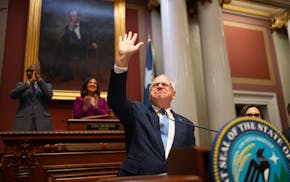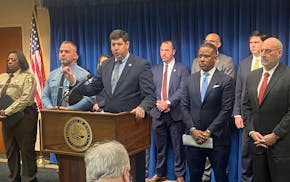Jesus Gonzalez wouldn't have been able to attend Concordia College without a Minnesota State Grant, the Moorhead senior said.
"It's incredibly powerful," Gonzalez said. "That extra support ... allows me not to worry about college [costs] and to do things like be involved in student leadership, to search for internships."
The financial aid program — Minnesota's largest — awarded $214 million to 68,000 undergraduate students in fiscal year 2023. But state officials now project a $211 million deficit in the program for the 2026-27 biennium.
The shortfall, which was recently disclosed in a report, is raising alarm among higher education leaders. They say that not fully funding the program would harm low- and middle-income students at private and public institutions who count on it to afford their education.
"This will be devastating to our students if the Legislature doesn't figure out a way to correct that mistake," said Kathleen Murray, acting interim president of Hamline University in St. Paul. "The neediest students ... will be negatively impacted by this. And we won't get them back."
Earlier this year, the program faced a $40 million shortage, so some students' financial aid awards were reduced at the last minute.
The cause of this year's deficit: Across the state, more students are attending college; more students are qualifying for the grants, and a larger share of students are low-income than in previous years.
"The Legislature made really big investments in higher education [and] ... really wanted to boost enrollment, and I think that likely we're seeing that bear fruit," said Nicole Whelan, the State Grant research analyst for the Office of Higher Education.
Other changes mean funding the program requires more money. More students are eligible and individual awards are larger because of changes to the Free Application for Federal Student Aid (FAFSA), which now assesses a family's financial need in a new way. Legislators also better aligned State Grant awards with the federal Pell Grant program, meaning undergraduates can receive the state aid for longer — up to six years, full time.
Several leaders said they hope the shortfall can be avoided — or its impact minimized. Office of Higher Education officials said addressing the gap was their No. 1 priority this session.
Rep. Gene Pelowski, DFL-Winona, said the good news is that a projected state budget surplus could be put toward the deficit. But as the outgoing chair of the Higher Education Policy and Finance Committee, he said it might be "a little bit difficult" to get done with the House split equally between Republicans and Democrats.
And there's still the question of how to fund the program long-term.
"There's no indication to me that this is a priority item," he said.
Multiple factors created shortfall
About 11,000 students at the 18 Minnesota Private College Council institutions received State Grant awards in fiscal year 2023. At Minnesota State, Chancellor Scott Olson said 40,000 students got the aid in 2024 and any shortfall could make attending college and finishing a degree harder for them.
After years of declining enrollment at colleges across the country due in part to demographic trends, state officials and other leaders said they're excited to see some Minnesota schools reversing that trend this fall.
The state is also slowly rebounding from a dramatic drop in college enrollment during the pandemic, said Paul Cerkvenik, president of the Minnesota Private College Council.
The Minnesota State system saw the most dramatic undergraduate enrollment increases this year, with 8.1% more students. But the University of Minnesota system and private, nonprofit colleges also saw increases — about 3.1% and 1.9%, respectively.
The popularity of the North Star Promise program, which offers free tuition to undergraduates at public institutions from families earning less than $80,000, was one factor in the enrollment spike, several officials agreed.
Direct admissions, a new initiative that offers high school seniors acceptance at some colleges without formally applying, also contributed, said Meghan Flores, the Office of Higher Education's manager of state financial aid programs.
Pelowski pointed to another factor in the grant program's shortfall — tuition increases at the U exceeded what legislators expected. He said he was disappointed in the hikes. At Minnesota State schools, tuition was frozen.
Jake Ricker, spokesman for the University of Minnesota system, said "tuition levels play a role" in the deficit. But, he said, tuition rates are requested by legislators before the U has a "clear view of total revenues and expenses to build our budgets for any given year."
Ricker said U officials had estimated a "range of increases of up to 4%" — tuition across the system came in at 3.7%, though the jump was 4.5% at the Twin Cities campus.
Changes at the federal level aimed at simplifying FAFSA and the increase in the number of students qualifying for Pell Grants affected the State Grant program's bottom line, too, Flores said. State Grant amounts are linked to Pell guidelines. Income thresholds for the Pell Grant — a form of need-based financial aid for low-income students — are now based on federal poverty guidelines, which take into account family size and other factors.
Flores said people have said for years they didn't believe that FAFSA fully accounted for the true cost of going to college. She said the changes attempt to reflect that.
"The goal was to measure people in a way that more accurately reflected their ability to pay," Flores said. "And when you measure them more accurately, more students qualify for aid."
Unlike Pell, the State Grant program targets "a little bit more of that middle income threshold," Whelan said.
Though about 65% of State Grant recipients' families make less than $50,000, a student from a family making $100,000 may still get the grant, she said.
What's next?
Barbara McDonald, president of the College of St. Scholastica in Duluth, said realization of the shortfall came late in this year's legislative session.
"It's very unfortunate because the State Grant is for every single student going to college, regardless of institution," she said.
Mike Dean, executive director of the nonprofit North Star Prosperity, said he worries college enrollment will decrease again if Minnesotans think financial aid is unstable or unreliable. That would affect the state's future workforce, he said.
When there are more eligible recipients for a program than resources, states can try to get more money, reduce the number of recipients or make cuts, Flores said.
Gov. Tim Walz's office said in a statement that Walz will issue his budget after the November forecast.
Sen. Omar Fateh, DFL-Minneapolis, said in a statement that he wants to fully fund the State Grant program in the coming legislative session. The program, he said, was a "top priority of mine."
Cerkvenik said the council leaders and students will advocate for it at the Capitol next year.
"Without it," he said, "this positive increase in enrollment ... could stop or reverse itself if students don't have the resources they need to afford college."

As Rep. Angie Craig takes her town halls to greater Minnesota, Republican colleagues say she may be violating House ethics rules

Gov. Walz excoriates Trump, offers olive branch to MN Republicans in State of the State speech

Minnesota county commissioner, whose wife wanted him to step down due to cognitive concerns, resigns

Federal jury convicts three Minneapolis 'Highs' gang members of murder, racketeering
